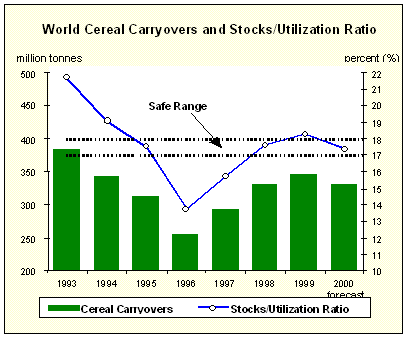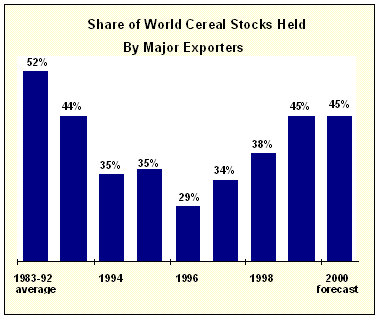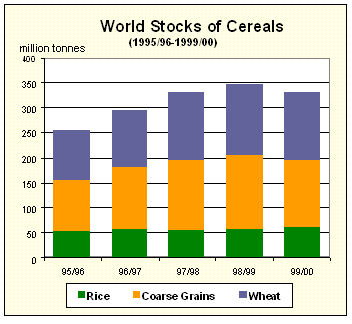


The forecast for global cereal stocks by the close of the current seasons ending in 2000 has been lowered slightly from the previous report to 332 million tonnes (Table A.5). Latest information points to a likely stronger decline in maize carryovers in China and some of the major exporting countries. At the current forecast level, world cereal carryover stocks would be 14 million tonnes, or 4 percent, below their opening level. All of the anticipated reduction is in stocks of wheat and coarse grains as rice inventories are expected to increase for the second consecutive year. Overall, the ratio of global cereal carryovers to trend utilization in 2000/01 is put at 17.4 percent, unchanged from the previous report, which is within the 17-18 percent range that the FAO Secretariat considers as the minimum necessary to safeguard world food security. In addition, the percentage share of global cereal stocks held by major exporters, another indicator of global food security, is expected to remain unchanged at around 45 percent.

World wheat inventories for crop years ending in 2000 are likely to decline to 136 million tonnes, down 4 million tonnes, or 3 percent, from their opening level. This decline is slightly less than was reported earlier but would still represent the first drawdown in 4 years.

Countries where this year's ending stocks are likely to decline significantly include China (down 3 million tonnes), Turkey (down 1.5 million tonnes), Syria (down 1 million tonnes), the Russian Federation (down 1 million tonnes), and the Islamic Republic of Iran (down 700 000 tonnes). In most of these countries, the reductions in stocks would be on account of lower domestic production.

Total wheat inventories held by major exporting countries are expected to remain unchanged from their relatively high opening levels, at around 51 million tonnes (Table A.4). However, this would be mainly because of larger carryovers in the United States, which are forecast to be up 1.4 million tonnes from previous year. Among the other major exporters, in the EC a combination of smaller production and larger exports could result in some 2 million tonnes reduction in stocks. In Canada, despite a rise in production, ending stocks are likely to remain close to their opening levels, mostly because of a sharp boost in exports. A record wheat production in Australia could result in higher stocks there, although exports are also expected to increase sharply.
| Crop year ending in: | |||
| 1998 | 1999 estimate | 2000 forecast | |
| (. . . . million tonnes . . . .) | |||
| Wheat | 135.6 | 139.9 | 135.6 |
| Coarse grains | 140.2 | 149.4 | 137.5 |
| Rice (milled) | 54.8 | 56.5 | 59.0 |
| TOTAL | 330.6 | 345.8 | 332.1 |
| of which: | |||
| Main exporters | 126.5 | 154.1 | 148.0 |
| Others | 204.1 | 191.7 | 184.1 |
The forecast for coarse grains inventories for crop years ending in 2000 has been lowered since the last report, by 4 million tonnes, to 137.5 million tonnes. At this level, world coarse grain stocks would be 12 million tonnes, or 8 percent below their opening level and the smallest in 3 years. Continued large maize exports from China could result in smaller carryovers given the decline in its domestic production in 1999. The estimate for aggregate coarse grains stocks held by the five major exporters has also been lowered this month to 77 million tonnes. The forecast for ending stocks in the United States has been lowered by 3.7 million tonnes, to 49.5 million tonnes. At this level, coarse grain inventories in the United States would be slightly below last year, following reduced output and a strong growth in domestic feed use. Another significant decline in inventories is expected in the EC, where a decrease in 1999 production is expected to result in some 5 million tonnes drawdown on stocks, mostly of barley.
Based on the current tentative cereal production forecasts for 2000 and the projected utilization level in 2000/01, early indications for global cereal stocks by the close of crop years ending in 2001 point to a further
drawdown of at least 8 million tonnes, or 2 percent, from this year to about 324 million tonnes. The bulk of the reduction is expected in North Africa and in Asia, especially in China. Total stocks held by the major exporting countries may also decline, albeit slightly. Among the individual cereals, wheat and rice stocks are expected to contract but coarse grain inventories could increase somewhat.